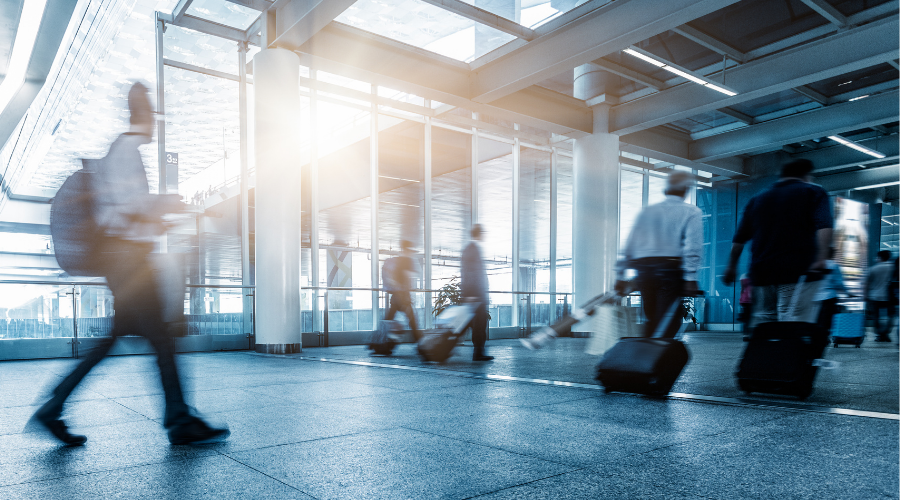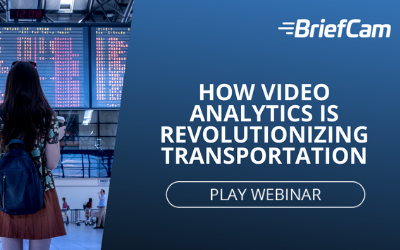Optimize Airport Security, Customer Service and Operations with Video

Get More Value from Video Surveillance Networks
It’s little surprise that airport travel has diminished as a result of the COVID pandemic; according to the US Transportation Security Administration (TSA), passenger throughput is a fraction of what it was in the previous year, and in August this year, NPR reported that international travel is merely 2-4% of what it had been. In the US, airlines have benefitted from the government’s CARES Act in March, which provided some immediate financial relief for passenger airlines, but that government support is slated to end on September 30, and it is unclear whether there will be a CARES 2 Act or an executive action to further help the aviation industry. When airline travel suffers, airport terminals lose revenue. Therefore, from a business perspective, airport terminals should seek every opportunity to reduce costs and get more value from their existing investments.

One of the existing technologies they can capitalize on is video surveillance (CCTV) systems. Every airport has some form of video surveillance, to monitor the various areas of a terminal and public areas (runways, cargo areas, tarmacs, ticketing and baggage areas, security lines, gates, offices, loading docks, customs facilities, maintenance areas, food courts, etc.) In the past airports primarily used video surveillance for security purposes; i.e., to monitor queues, identify potential terrorist threats, locate missing persons, and investigate incidents. However, in recent years airports have realized that video footage contains volumes of valuable data that can help not only security, but also operations and customer service teams.
The key to unlocking that valuable data is AI-driven video analytics software, which identifies, classifies and indexes objects in surveillance video footage to make it searchable, actionable and quantifiable. Video content analytics software detects, identifies, extracts and catalogs objects in video and then drives analytic activities (such as count-based alerts and dashboard reports) based on the extracted and classified data. The analysis is performed in real-time, as well as over extended periods of time (hours, days, weeks, years, etc.). The technology thus enables system operators to improve their awareness of situations in real-time, gather long term trend data and carefully review incidents in their immediate aftermath.
Accelerate Security Investigations
To accelerate post-incident security investigations operators can apply the comprehensive search and filter functions of video content analytics software to review hours of archived footage, from across multiple cameras, in a matter of minutes. Operators can search video footage according to a variety of attributes such as clothing type, gender, adult or child, vehicle type and color, direction of travel, etc. to derive evidence and pinpoint persons of interest. A filtered search eliminates irrelevant objects, to help investigators quickly pinpoint suspects or vehicles in a variety of incident scenarios, such as criminal investigations or unauthorized entry to sensitive areas, as well as missing persons.
Improve Situational Awareness with Real-time Alerts
By analyzing video data that has aggregated over time to determine normal trend data, operators can benchmark what is normal and define anomalous behavior. Is there normally no luggage in a certain area, or has a piece of luggage been in an area for an unusually long time? Video content analysis can be configured to send real-time, rule-based alerts to security whenever such anomalies occur.
Monitor Crowds and Queues
Airport security staff monitor various areas, such as check-in stations or customs, to make sure that crowds don’t form. Count-based alerts trigger notifications for a specified number of objects (e.g., people or vehicles) or a concurrent number of objects in an area in a predefined time period. Rather than relying on human observation, operators can receive an alert if an unusually large number of people are dwelling in a pre-defined area within a specified time period. Management can then assign additional staff as needed to resolve long queues, or redirect airport visitors to less crowded areas.
Pinpoint Unauthorized Persons or Terrorists with Facial Recognition
Given that TSA officials are always on the lookout for potential terrorists, in the wild facial recognition is becoming a widely used form of biometric technology. Security teams can upload a digital watchlist of video or still images of persons of interest or suspects; video intelligence software can then be configured to send a real-time alert whenever a potential face match is detected. An operator can then review the data and confirm the accuracy of the match.
Respond to Suspicious Behavior of Persons of Interest
In addition to looking for terrorists, security teams must prevent injuries or theft by ensuring that no unauthorized people enter restricted areas, whether intentionally or by mistake. In such cases, the facial recognition software may be configured to send a real-time alert when someone whose face is not on a digital watchlist of approved faces enters an area that is off-limits to them.
Search for Persons of Interest or Missing Children
It’s not just for finding “bad guys.” In jurisdictions where it is allowed, facial recognition can be used to locate a missing person. However, oftentimes, facial recognition is not authorized, in which case it is beneficial for operators to have the option to leverage more extensive video analytic search functionalities based on object descriptions and classifications (child, wearing blue coat, white hat). This is crucial to help detect appearances of kidnapped children who are transported through a terminal, or children or seniors who have become separated from their party.
Quantify Unique Visits with Face Re-identification
Often airports seek data regarding how many passengers vs. employees are passing through an airport or terminal within a particular time period (daily, weekly, etc.). Using face recognition-driven re-identification, video analytics system operators can more accurately understand and report on unique terminal traffic that excludes airport staff. Based on a face recognition staff identity list, the system can distinguish between employee and passenger traffic, for real-time or aggregated data reporting. Management teams can also measure unique visits, duration of visits, and how individual visitors navigate terminals.
Collect Operations Trend Data
Even without face recognition and re-identification to generate unique traffic statistics, video analytics extracts critical information about the environment that can be applied to improve operational performance. The software can collect and analyze data regarding anonymized pedestrian and vehicle traffic volume and pathways, and deliver that information in easy-to-read heat maps and customizable dashboard reports. For example, managers often need to know the average length of time that visitors are dwelling in certain areas such as TSA checkpoints, taxi queues, customs, etc. Managers also need to know common navigation pathways, and which entrances and exits have the highest/lowest volume, so they can plan staffing, signage, or construction accordingly. These decisions directly impact efficiencies for staff and travelers. And, to make data-driven decisions about scheduling and services, management teams need quantifiable data about traffic patterns, such as the number of cars entering specific parking lots or pedestrians walking through terminals.
Improve Customer Service and Optimize Airport Layouts
In addition, video data is used to derive business intelligence to improve customer service, retail, and marketing departments. Terminal managers can view heatmaps to quantify the amount of visitor traffic in various areas of a terminal, to justify the amount of rent they charge for particular retail stores or kiosks. Those data points also help managers make better decisions about terminal layout, and where to place services, staff, or kiosks. Marketing teams can also use video analytics to gather demographic information, beyond how many visitors pass through a terminal at any given time of the day, week or year, they want to know the percentages of men, women and children, to inform their airline and retail tenants.
Summary
Airport operators are facing difficult financial times in 2020 and for the foreseeable future. They can’t cut corners on security because public safety is their highest priority; they have an ethical obligation to protect passengers and airline tenants. They also must ensure customer satisfaction, to maintain revenues. The good news is, they can use technology solutions to reduce operational costs and increase efficiencies. Given that video surveillance cameras are already widely used in airport terminals, airport management teams can easily extend the value of those camera networks by implementing complementary technology such as video content analytics. Such software can be the key to improving security and streamlining operations, without having to allocate major budget and people resources.
Signup to receive a monthly blog digest.